|
|
|
Sort Order |
|
|
|
Items / Page
|
|
|
|
|
|
|
| Srl | Item |
| 1 |
ID:
148941
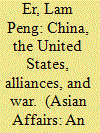

|
|
|
|
|
| Summary/Abstract |
Chinese President Xi Jinping emphatically rejects the so-called Thucydides Trap and its analogy that a rising China is destined for war with the United States, the status quo great power. But there is a contradiction between Beijing's peaceable rhetoric about a “New Type of Major Power Relations” with the US, and Beijing's disregard for the US and its allies. concerns about rising Chinese assertiveness in the East and South China Seas. It is not inconceivable that smaller Chinese and American allies in East Asia might well drag the US and China into a conflict rather than a conflict directly caused by the “power transition” between the two great powers per se.
|
|
|
|
|
|
|
|
|
|
|
|
|
|
|
|
| 2 |
ID:
173931
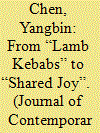

|
|
|
|
|
| Summary/Abstract |
This article primarily pays attention to Han Chinese appropriations of Uyghur culture from the post-Mao era. A unique case is comedian Chen Peisi’s role of Uyghur lamb kebab peddler in a TV sketch in 1986. The root of the cultural appropriation is to re-essentialize Uyghur culture to quell the demand by the majority Han Chinese for cultural consumption in the market economy era. The author further examines a similar case of Chinese appropriation of African culture in 2018. In the end, the article argues that deeply-rooted cultural ignorance from Han Chinese towards ethnic and racial “others” is still prevalent today, which poses a subtle challenge to the Party-State’s lofty goal of building people’s bonds within the One Belt and One Road Initiative.
|
|
|
|
|
|
|
|
|
|
|
|
|
|
|
|
| 3 |
ID:
152542
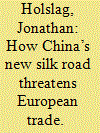

|
|
|
|
|
| Summary/Abstract |
For all the promises of mutually beneficial cooperation, Chinese policy documents about the New Silk Road, also called ‘One Belt, One Road’, mostly testify to a strong ambition to unlock foreign markets and support domestic firms in taking on foreign competitors. This confirms China’s shift from defensive mercantilism, which aims to protect the home market, towards offensive mercantilism, which seeks to gain market shares abroad. In a context of global economic stagnation, this comes as a major challenge to Europe. As China’s market share grows spectacularly in countries along the New Silk Road, key European member states have both lost market shares and even seen their exports shrink in absolute terms.
|
|
|
|
|
|
|
|
|
|
|
|
|
|
|
|
| 4 |
ID:
153116


|
|
|
|
|
| Summary/Abstract |
China’s ‘One Belt, One Road’ (OBOR) initiative is a grand plan to connect Asia, Europe and East Africa
economically. However, from India’s point of view, China’s attempt at what it describes as geo-economic
expansion appears as a geopolitical threat because of China’s activity in the Indian Ocean Region (IOR).
This essay assesses the extent to which OBOR is (i) realistic and achievable, (ii) a genuine threat to India
and (iii) amenable to possible Indian involvement. It concludes that India should continue to be wary of
its neighbour in national security terms, but has no option but to cooperate with China economically by
participating in OBOR if it seriously wishes to increase economic growth and bring the ‘Make in India’ and
Sagarmala projects to fruition. In particular, India should seriously consider allowing Chinese companies
to develop one or more Indian ports with associated infrastructure and manufacturing
|
|
|
|
|
|
|
|
|
|
|
|
|
|
|
|
| 5 |
ID:
140313
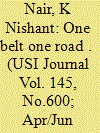

|
|
|
| 6 |
ID:
155343
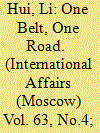

|
|
|
|
|
| Summary/Abstract |
THE ONE BELT, ONE ROAD (OBOR) initiative is the most wide-ranging public project that China has proposed to the global community so far. Since 2013, when the initiative was put forward, it has been joined by more than 100 countries and international organizations, with over 40 states signing cooperation agreements with China. China's aggregate trade with countries along the OBOR line has totaled $3.1 trillion. Chinese corporate investment in these countries has exceeded $49.3 billion. Fifty-six trade and economic cooperation zones have been created in 20 countries with an accumulated investment of $17.9 billion, which has generated $960 million in tax revenues and 163,000 jobs for the host countries, stimulated economic development, and benefited the global economy.
|
|
|
|
|
|
|
|
|
|
|
|
|
|
|
|
| 7 |
ID:
175943
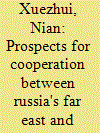

|
|
|
|
|
| Summary/Abstract |
Since 2012, Russia is accelerating the pace of the Far East development. Preferential regimes for attracting investments, such as Priority Development Area (PDA), The Free Port of Vladivostok, etc. were developed and launched. At the same time, the Northeast Asian countries put forward a number of new state strategies in the sphere of international cooperation: The One Belt, One Road initiative, the New Northern Policy, the Nine Bridges, and the Eight-Point Cooperation Plan. The interlocking of these strategies gave a new impetus to the priority development of the Russian Far East.
|
|
|
|
|
|
|
|
|
|
|
|
|
|
|
|
| 8 |
ID:
166801
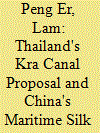

|
|
|
|
|
| Summary/Abstract |
China today has the interest, money and technology to build the Kra Canal in Southern Thailand consonant to Chinese President Xi Jinping's grand strategy of a Maritime Silk Road. Notwithstanding China's rise and friendly relations with Thailand, the Kra Canal project has stalled due to gridlock in Thai domestic politics. Beijing cannot simply impose its infrastructural preferences on Bangkok but needs the latter's consent. Thus far, that consent is not forthcoming. But if the construction of the Canal were to proceed ahead unexpectedly and quickly, it could be a navigational, trading and geopolitical game changer upon completion in Southeast Asia.
|
|
|
|
|
|
|
|
|
|
|
|
|
|
|
|
|
|
|
|
|